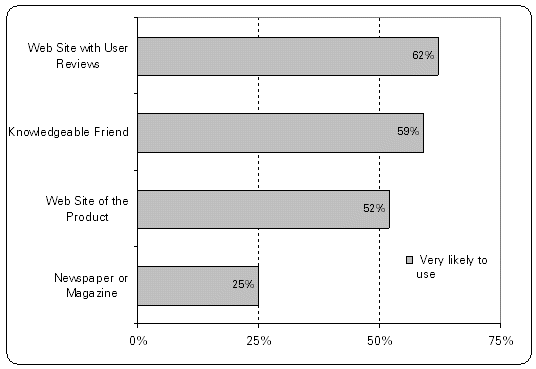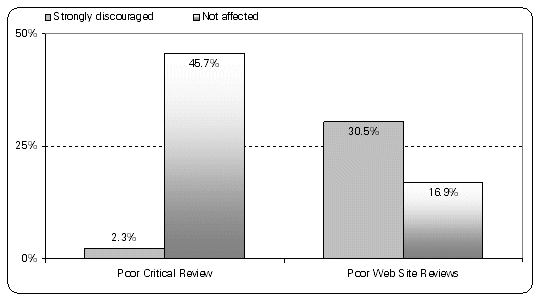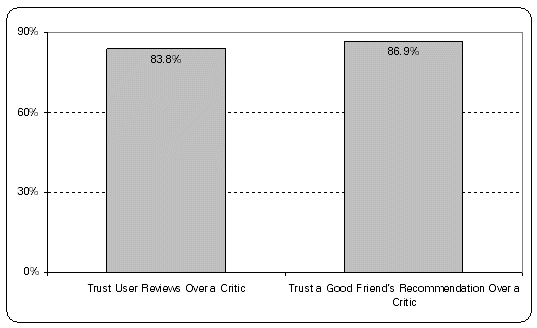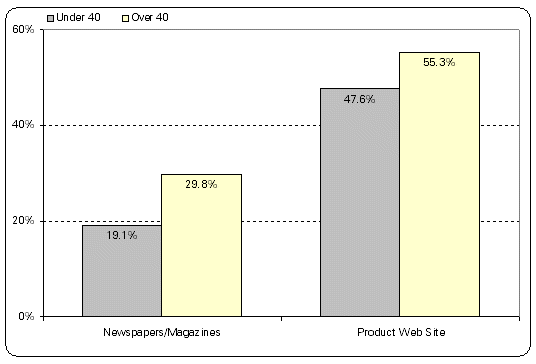It’s no secret that user reviews are a powerful marketing tool. 58% of ecommerce buyers prefer sites with user reviews, according to MarketingSherpa’s 2007 Ecommerce Benchmark Guide, and 44% of the large ecommerce sites surveyed offer user review or ranking features.
But new data sheds light on just how influential those user reviews can be -- and not just for ecommerce sales but for products or services that depend on the user’s experience.
A new survey by entertainment directory Goldstar Events Inc. of its membership base reveals stunning insights into how much more effective user reviews can be than reviews by critics in traditional media. What’s more, such reviews are almost as influential as a recommendation from a close friend.
“We’re definitely in an era where the ethos is, ‘I’ll judge for myself. I don’t need an expert to tell me what to think or buy or see,’ ” says Jim McCarthy, CEO, Goldstar Events.
Although the survey was conducted with a unique audience base -- Goldstar members who have signed up to receive recommendations for live events, such as plays and musical performances -- the results have implications for marketers considering their own user review strategies. Here are four new charts highlighting key takeaways:
Chart 1. Where Users Prefer to Get Purchase Data Information © 2007 Copyright Goldstar Events Inc.
© 2007 Copyright Goldstar Events Inc.
Source: ‘Entertainment Habits Survey Results, May 2007’
Methodology: The survey was created by Goldstar Events and fielded to members on May 3, 2007. The survey was closed on May 25, 2007, with 1,502 responses.When asked what sources of information they are “very likely” to consult before making a decision about their entertainment options, 62% named Web sites with user reviews as their top choice, even beating out a knowledgeable friend (59%).
The gap was even wider with product Web sites and newspaper and magazine reviews (52% and 25%, respectively). In this case, it appears that user reviews are especially important for products or purchases that are experiential in nature -- something that can’t be touched or felt in advance and can’t be returned if it doesn’t live up to the user’s expectations.
Vendors of services, for example, might take note of these results and consider their own user review strategies. It’s critical to have a source of user reviews to help buyers make their purchasing decisions.
Chart 2. How Does a Bad Rating on a User Review Web Site Affect Buying Decisions? © 2007 Copyright Goldstar Events Inc.
© 2007 Copyright Goldstar Events Inc.
Source: ‘Entertainment Habits Survey Results, May 2007’
Methodology: The survey was created by Goldstar Events and fielded to members on May 3, 2007. The survey was closed on May 25, 2007, with 1,502 responses.Digging deeper into the importance of user reviews, Goldstar asked users how a negative media article affects their decision vs a negative user review on a Web site. The difference in the behavioral-altering ability of the two sources was significant.
Only 2.3% said they would be strongly affected by a negative critical review compared with 45.7% who said it would have no effect at all. By comparison, 30.5% of users said they would be strongly affected by a negative user review, while only 16.9% said there would be no effect at all.
Such results reiterate the notion that the so-called authorities on a subject in the Web 2.0 world might not enjoy the authority they used to have. By contrast, even a small difference in the number of negative reviews is enough to harm a product’s ranking among consumers.
In a recent MarketingSherpa study of top-ranked and bottom-ranked consumer electronics products (as rated by Consumer Reports), even the top-ranked products received 21% negative reviews. For bottom-ranked products, only a slight uptick in negative reviews to 34% was enough to help skew the overall negative impression of a product.
Chart 3. Influence of User Reviews Vs a Friend’s Endorsement © 2007 Copyright Goldstar Events Inc.
© 2007 Copyright Goldstar Events Inc.
Source: ‘Entertainment Habits Survey Results, May 2007’
Methodology: The survey was created by Goldstar Events and fielded to members on May 3, 2007. The survey was closed on May 25, 2007, with 1,502 responses.A recommendation from a friend can be one of the most powerful influences in a customer’s purchasing decision. But according to Goldstar’s data, good user reviews can have the same impact.
86.9% of respondents said they would trust a friend’s recommendation over a review by a critic, while 83.8% said they would trust user reviews over a critic. This influence makes user reviews a good marketing tool for vendors with low promotional budgets. The key, though, is to have a wide sampling of user reviews available for potential customers to see.
One positive review might not carry the same influence as a recommendation from someone a user knows and trusts. However, seeing positive reviews from a range of happy customers changes the equation. Web users tend to study online reviews for someone just like themselves, whose opinion, experience and needs are similar. And even if they don’t find a response from someone who appears to have the same taste and needs, the weight of 10, 20 or 30 positive reviews can give them confidence that a product or service delivers on its promises.
When designing a user-review feature on a Web site, consider ways to encourage robust responses from users that populates your review database. Here are two techniques to consider:
- Restaurant and entertainment rating site Zagat.com launched a user review feature in late 2006 by sending an email to all members that offered a free dinner for two to the member who posted the most new reviews online. The email received a 21% clickthrough rate and resulted in 5,000 reviews being added to their database.
- When online paperback rental service Booksfree.com added user book reviews earlier this year, it announced the feature on its company blog, which is one of the site’s top-10 traffic generators. Within hours of the announcement, members had posted more than 20 reviews.
Chart 4. Over 40 Vs Under 40: Who Uses What Information Source? © 2007 Copyright Goldstar Events Inc.
© 2007 Copyright Goldstar Events Inc.
Source: ‘Entertainment Habits Survey Results, May 2007’
Methodology: The survey was created by Goldstar Events and fielded to members on May 3, 2007. The survey was closed on May 25, 2007, with 1,502 responses.Hoping to clarify the importance of user reviews to different age groups, Goldstar broke down its responses by members under age 40 and over age 40. Not surprisingly, the older demographic was more likely to use magazines, newspapers and company Web sites as a source of information.
Nearly 30% of respondents over 40 said they were “very likely” to use newspaper or magazine Web sites, compared with 19.1% of users under 40. Likewise, 55.3% of respondents over 40 said they were very likely to use a product Web site vs 46.7% of users under 40. However, while some gap was expected, McCarthy says he was surprised by how much interest the older demographic also expressed in user reviews.
Indeed, MarketingSherpa data confirms that even among older consumers, online reviews are one of the most widely adopted features for online purchasing behavior. While 50% of consumers ages 18-34 said they had posted an online comment or review of a product or company, 45% of consumers ages 35-54 said they had as well, and 34% of consumer over age 55 weighed in with an online opinion.
So, even though a marketer aiming for an older customer base needs to cater to that audience’s comfort with traditional media reviews and company-specific marketing information, the older online audience tends to act more like their younger online counterparts than they do older, offline consumers. Don’t assume age simply means an unfamiliarity with the value of Web 2.0 features.
Useful links related to this articleEntertainment Habits Survey Results, May 2007
http://www.goldstarevents.com/presentations/gse_entertainment_habits_survey_2007.pdfPast Sherpa Case Study: Zagat’s Web 2.0 Efforts Get Double-Digit Subscriber Growth:
http://www.marketingsherpa.com/article.html?ident=29897
Past Sherpa article: How Marketer Grows Subs 22% With Limited Ad Budget - 3 PR Secrets and Other Tips:
http://www.marketingsherpa.com/article.html?id=30021
Goldstar Events Inc.:
http://www.goldstarevents.com/













